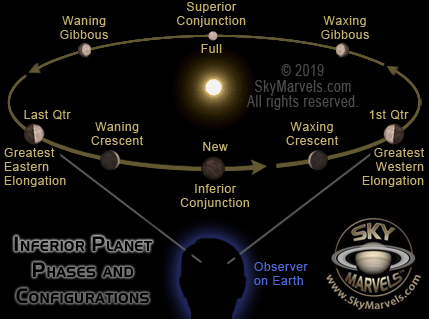
MERCURY VIEWED FROM EARTH
Image Credits: NASA/JPL Solar System Simulator developed by: David Seal
FOV: 60° Magnification: 0.5x (shows entire orbit) Inner Planet Orbits Greatest Elongations 2024 Skypath 2024
L O A D I N G 
Note: 1) from Earth, Mercury's orbit appears "edge-on" in early May and early November;
2) from Earth, Mercury's orbit stretches rouughly 1/8 of the way around our sky.
FOV: 30° Magnification: 1x (naked eye) Location in Constellations
FOV: 2' (arc-min) Magnification: 900x Compare Current Planets
L O A D I N G 

FOV and Magnification vary so Mercury fills image
Because Mercury is one of the two Inferior Planets—that is, like Venus its orbit is smaller than Earth's—the following image will help you relate its current phase to its position in orbit.

Bonus: Mercury's Current Position Over Earth

Showing Mercury's current position over Earth, the bonus view above therefore also shows the half of Earth that currently has Mercury visible in its sky—weather permitting, of course. If a location is on the half of Earth shown above, then Mercury is in its sky as follows. The closer a location is to the view's center, the higher Mercury will be in its sky. Likewise, the closer a location is to the edge of the above globe, then the closer Mercury will be to its horizon. And don't forget—Earth rotates to the east (left to right in the image above). So, generally, (in all places except the polar regions), Mercury is currently rising at the "left edge" of Earth, and setting at its "right edge". But remember, great care must be exercised when trying to view Mercury, as it is never wanders father than about 28° from the Sun. Most of the time it is much closer than that. This is why—in all but the polar latitudes—Mercury can never be seen more than two hours before sunrise nor after sunset. Generally, it is most easily seen when it is near or at Greatest Elongation, because that is when it appears fathest from the Sun's brilliance.
Simulator Image Notes: 1) Fields of View are measured horizontally. 2) Top orbital view orientation: Sun's local north "upward", i.e. in
the 12:00 midnight direction. 3) Second orbital view orientation: Ecliptic north "upward". 4) Mercury surface views' orientation: planetary local north "upward". 5) Simulator renders in detail only the part of Mercury's suface that was available prior to Messenger mission. This should not be confused with the portion in shadow. 6) Light-Travel Time is not included in calculated times.
Home Intro News Gallery Sky-Gifts Bonuses Tips
Learning Ctr Help Links Credits Legal Contact Us
© 2007-
by Gary M. Winter. All rights reserved.
Interested in political cartoons and humor?
Check out The HIPPLOMATS™.
SkyMarvels, Sky Marvels, SkyMarvels.com, - CURRENT VIEW OF MERCURY FROM EARTH. Mercury's Current Phase, Mercury's Current Distance from Earth, Mercury's Current Apparent Size from Earth, Mercury's Current Distance, Mercury's Current Apparent Size, celestia4all, celestiaforall, CELESTIA, astronomy, space, simulations, animations, downloadable astronomy posters, stars, planets, Inner Planets, Outer Planets, Inferior Planets, Superior Planets, moons, asteroids, comets, Oort Cloud, galaxy, galaxies, Milky Way, Andromeda, globular clusters, binaries, quasars, black holes, supermassive black holes, telescope, telescopes, planetarium, software, freestuff, satellites, add-ons, addons, scripts, eclipses, Solar Eclipses, Lunar Eclipses, Solar Eclipse Finder, Lunar Eclipse Finder, mutual eclipses, transits, occultations, Solar System, CELES-TOOLS, celeSTARrium, CELX, CELX programming, Freebies, multiple views, atronomical unit, light year, parsec, meteors, meteor showers, Perseids, Geminids, Leonids, barycenter, time, Time Zones, tides, alignments, conjunctions, oppositions, seasons, apogees, perigees, aphelion, perihelion, Earth, Luna, Mercury, Venus, Mars, Jupiter, Galilean Moons, Io, Europa, Ganymede, Callisto, Saturn, Titan, rings, Uranus, Neptune, Triton, E-MSpectrum, electromagnetic spectrum, astronaut, equinoxes, solstices, precession, rotation, spin, inclination, tilt, Ecliptic, orbits, ellipse, parabola, hyperbola
